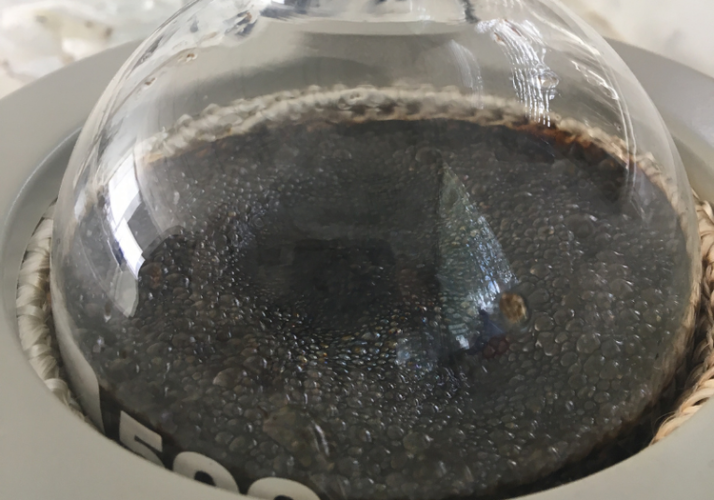Bitumen emulsions are partially composed of water. The water content greatly influences the behavior of the emulsion, whether during production, storage, or on the construction site. For these reasons, it is important to understand the role of water content in the field of bitumen emulsions, the methods for determining it in the laboratory, and the potential problems associated with it, which should always be avoided whenever possible.
Table of Contents
Definition
The water content of a bitumen emulsion refers to the mass percentage of water in the emulsion. In any bitumen emulsion formulation, the water content must be clearly indicated as a mass percentage. Generally ranging from 25% to 60%, the water content is directly related to the binder content of the emulsion, with these two terms often used interchangeably. The more binder an emulsion contains, the less water it has, and vice versa.
Role in Bitumen Emulsions
The water content directly influences the properties of the emulsion, such as its viscosity, stability, and breaking behavior. Generally, although there may be exceptions, the following is considered:
- The lower the water content of a bitumen emulsion, the higher its viscosity;
- The lower the water content of a bitumen emulsion, the lower its stability;
- This rule is reliable for water contents ranging from 25% to 40% (binder contents from 60% to 75%), as emulsions with higher water contents (lower binder contents) may present stability issues.
- The lower the water content of a bitumen emulsion, the faster it breaks.
Viscosity
Bitumen emulsions are composed of bitumen droplets dispersed in the aqueous phase and stabilized by emulsifiers. The higher the binder content (lower water content), the closer the bitumen droplets are to each other, causing them to interfere with one another. As a result, the bitumen droplets have less mobility. This decrease in the mobility of the bitumen droplets directly leads to greater resistance to flow in the emulsion, and therefore, a higher viscosity.
Stability
As mentionned above, the more the bitumen droplets interfere with each other, the more likely the emulsions are to be viscous. Similarly, the greater the number of bitumen droplets, the higher the chances that two droplets will meet and merge, forming a single larger droplet. If this phenomenon continues, the droplets become larger and larger, eventually becoming so big that they either settle to the bottom or rise to the surface. Therefore, the lower the water content, the greater the risk of stability problems in the emulsion.
Breaking
The breaking behavior is a complex phenomenon at the core of road construction techniques using bitumen emulsion. The breaking of bitumen emulsions can occur in several ways:
- Breaking by destabilization of the emulsifier: The emulsifier responsible for the stability of the emulsion no longer allows the bitumen droplets to repel each other, which leads to the coalescence of the droplets and thus to breaking.
- Breaking by removal of water: Water is gradually separated from the bitumen droplets, either by evaporation, by absorption into the aggregates, or by the adhesion of bitumen droplets to the surface of the aggregates.
The breaking mechanisms are often a combination of these two phenomena. For example, rapid breaking occurs when the bitumen droplets are attracted to the surface of the aggregates, expelling water to the outside. Additionally, the aggregates contribute to destabilizing the emulsifiers. In the case of slow breaking, water is removed by evaporation and by the gradual destabilization of the emulsifier as a result of its reaction with air.
Methods of determination
Water content therefore plays a major role in the field of bitumen emulsions, influencing the properties of the emulsions during production, storage, and application. It is therefore essential to control the water content of emulsions to ensure that it is compatible with the formulation and the intended application.
EN 1428 – Dean Stark Method
The standard method for determining the water content of bitumen emulsions is the Dean-Stark azeotropic distillation method, described in standard EN 1428. This method involves distilling the emulsion to collect the water in the Dean-Stark receiver. The volume of water is then measured, and the binder content is compared with the formulation and EN 13808 standard requirements. The Dean-Stark test, which can take between 1.5 and 2 hours, requires the use of a distillation solvent (the NF EN 1428 standard recommends using xylene). These solvents are toxic, so it is necessary to take appropriate measures to protect operators from solvent vapors and potential splashes.
EN 16849 – Moisture Analyzer (Desiccator Balance) Method
The method for determining water content using a moisture analyzer (desiccator balance) is an alternative to the Dean-Stark method. A few grams of emulsion are placed in a dish with a filter paper, and the sample is heated until all the water in the emulsion has evaporated. The binder and water contents of the emulsion are then calculated by comparing the mass of evaporated water to the initial mass of the sample.
This method is quick and easy to implement, and it also has the advantage of requiring no solvent nor cleaning. However, compared to the Dean-Stark test, it has a drawback: the heating temperature must be adjusted according to the flux oil content in the emulsion and the nature of the flux oil (mineral or biobased). For emulsions containing more than 1.5% mineral flux oil or more than 5% of biobased flux oil, the moisture analyzer method will not provide a reliable value for water content, due to the risk of flux oil evaporation.
EN 1431- Distillation Method
The water content of bitumen emulsions can also be determined by distillation according to standard EN 1431. The principle of this test is similar to that described in standard EN 1428, although the oil distillate method does not require a distillation solvent. The emulsion sample, placed in a closed vessel, is heated with a gas burner until the distillate volume stabilizes. This test also makes it possible to isolate the oily fractions of the binder, which may come from the bitumen’s flux oil, and which can be useful to characterize.
Production Issues Related to Water Content
As previously stated, the water and binder contents of a bitumen emulsion are determined by the specific requirements of the intended on-site application. A binder content that is too high or too low can therefore compromise the success of the project or significantly reduce the lifespan of the structure. Standard NF EN 13808 allows for a tolerance in the binder content of bitumen emulsions: a C60 emulsion (cationic with 60% binder) can have a binder content between 58% and 62%, which is a tolerance of ±2%. These figures are listed in Table 2 (page 12) of the NF EN 13808:2013 standard.
If the binder content does not comply with the specifications, several problems can arise:
Viscosity:
A binder content that is too low (water content too high) leads to a decrease in the viscosity of the emulsion. The emulsion may become too fluid for its intended application: a mixing emulsion could flow to the bottom of the loose mix, while a surface dressing emulsion could run off the pavement. The coating is no longer homogeneous—some areas will be too rich in binder while others will lack it, and defects are likely to appear quickly.
A binder content that is too high (water content too low) leads to an increase in the viscosity of the emulsion. The emulsion may become too thick for its intended application: a mixing emulsion may not properly coat all the aggregates, while a impregnation emulsion may remain on the surface without being able to penetrate the substrate. The coating is no longer homogeneous—some areas will be too rich in binder while others will lack it, and defects are likely to appear quickly.
Stability and Breaking:
Bitumen emulsions are formulated in the laboratory to meet specific requirements. Parameters such as the type of emulsifier, emulsifier content, and acid content are adjusted to achieve the best results on site. Producing an emulsion with a binder content that does not match the formulation exposes you to major issues, particularly regarding the stability and breaking behavior of the emulsion. If there is too much bitumen in the emulsion, the emulsifier and activator contents may not be sufficient to stabilize the mixture, which could result in premature settling of the emulsion or excessively rapid breaking on site. If there is not enough bitumen in the emulsion, the repulsive forces between the bitumen droplets are no longer optimal, and the emulsion may become unstable or exhibit abnormal breaking behavior.
Conclusion
The water content of a bitumen emulsion is a key parameter available to the formulator in the laboratory for developing the formula that best meets the needs of the construction site. Once this parameter is set, industrial production must be rigorously controlled to ensure that the water content complies with the formulation, thereby maximizing the chances of project success. There are several methods for determining the binder content of bitumen emulsions, allowing the most suitable test to be selected according to current standards, the formulation, and the equipment available in the laboratory.



 Français
Français Español
Español